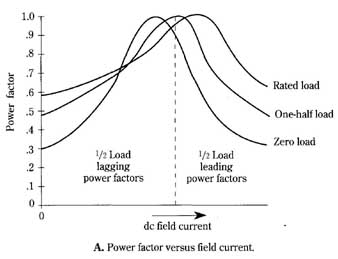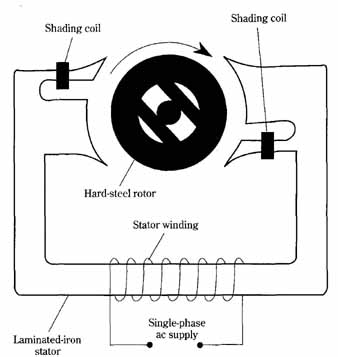AMAZON multi-meters discounts AMAZON oscilloscope discounts
The hysteresis synchronous motor is primarily encountered in fractional horsepower sizes. Its most common application has been in electric clocks and in other timing de vices. In larger sizes, and in somewhat modified form, it has also been widely used in tape recorders and phonographs. FIG. 24 illustrates the clock version, known as the Warren Telechron motor. The stator of this motor is similar to that employed in the shaded- pole induction motor. The rotor, however, is unique. Essentially, it comprises two or more hard-steel disks stamped out in the pattern shown. Hard steel is used because it’s necessary that the material have an appreciable amount of magnetic retentivity Cobalt steel has frequently been used as the rotor material for synchronous motors.


FIG. 23 The effect of field current in the synchronous motor. A. Power
factor versus field current. B. Stator current versus field current.

FIG. 24 The basic hysteresis synchronous motor.
When this motor is connected across the AC line, initial torque is developed in much the same manner as it’s in a shaded-pole, squirrel-cage induction motor. The high resistivity of the steel, together with the dissipational losses caused by magnetic hysteresis, lowers the efficiency of the motor but greatly increases its starting torque.
Operating in the induction-motor mode, the rotor is brought close to synchro nous speed. Unlike the squirrel cage of the shaded-pole induction motor, the steel rotor of this motor exerts a final burst of torque and attains synchronism with the rotating magnetic field provided by the stator. Once revolving at synchronous speed, the rotor strongly opposes any tendency to change its speed. This “locking” phenomenon results from the fact that the rotor provides minimum magnetic reluctance along the length of its cross bars. The rotor develops fixed magnetic poles because of these cross bars, causing the motor to behave as if it had a simple two-pole bar magnet spinning within the stator structure. The synchronous speed for 60-Hz excitation is, therefore, 3600 RPM.
Even if the rotor should become completely demagnetized under certain conditions, the motor would still start as described and pull into synchronism. The real importance of the magnetic poles formed in the rotor when it’s operating at synchronous speed is the hysteresis produced. As previously stated, such a loss mechanism in the rotor actually increases the amount of torque that is developed. This is important with regard to starting, pulling into synchronism, “locking” at synchronous speed, and turning the external mechanical load.